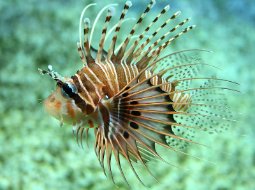
Loading Aqualapp ...
Care and Compatibility of Lionfish - Pterois volitans
Introduction
The lionfish, scientifically known as Pterois volitans or Pterois miles, is an invasive species native to the Indo-Pacific. It is characterized by its striped body, large pectoral fins, and venomous spines. Although it is a beautiful addition to the marine aquarium due to its exotic appearance, its introduction can have serious consequences for local ecosystems due to its predatory nature and ability to reproduce rapidly.
Behavior
The lionfish is a voracious predator that can be aggressive towards other fish and marine life in the aquarium. It has venomous spines on its dorsal fins that can cause painful injuries, so it should be handled with care. The lionfish tends to be unsociable even with other lionfish in an aquarium. They can tolerate the presence of other lionfish in the same tank, but they usually compete for territory and resources. In some cases, this competition can lead to aggression between lionfish, especially during feeding or if they feel threatened. Due to their territorial and aggressive nature, it is recommended to keep only one lionfish per tank unless the aquarium is large enough to provide multiple territories and hiding places. It's important to carefully consider the compatibility of tank mates before adding a lionfish to a community tank to avoid potential conflicts and injuries to other aquarium inhabitants.
Sexual Dimorphism
Sexual dimorphism in lionfish is not easily discernible to the naked eye. Both sexes have a similar appearance, although females may be slightly larger than males on some occasions.
Reproduction
Breeding lionfish in the aquarium is possible but can be difficult to control due to their prolific nature. They are broadcast spawners, releasing large quantities of eggs in a single spawning event. The eggs and larvae are pelagic and can be challenging to rear in captivity.
Aquarium Conditions
To keep a lionfish in the marine aquarium, a sufficiently large tank with ample hiding places and rocks to explore and hide is required. The water should be kept clean and well-oxygenated, with a temperature between 24°C and 27°C.
Feeding
The lionfish is an opportunistic predator that feeds on a variety of small fish, crustaceans, and other marine organisms. In the aquarium, it will accept a varied diet including shrimp, crabs, small fish, and frozen or live foods.
Complexity
The lionfish can be a challenging addition to the marine aquarium due to its predatory and venomous nature. It is recommended only for aquarists experienced in handling aggressive marine fish and understanding aquarium maintenance requirements.
In case you need more help, or if you want to know into any topic related to the Pterois volitans (Lionfish) and even any other species you can use the forums to ask what you need.
To do an analysis more detailed about coexistence and behavior of Pterois volitans (Lionfish) use the Aquarium simulation tool, if you do this you can test different ways to combine the Lionfish with other fishes giving the dimensions and space on you aquarium, on this way you can known the optimal configuration for keep the fishes that you want.
You can also find out the 1 species compatible with the Pterois volitans (Lionfish) can live together.
Note: The parameters of the water such as PH and temperature are also used to calculate the compatibility of the species.
Compatible species (1)
No species is compatible with the Lionfish, however, 1 fish are semi compatible with the Lionfish with certain conditions special.
With Reservation (1 Species)
The lionfish tends to be solitary even with its own kind in an aquarium. Although they may tolerate the presence of other lionfish in the same tank, it is more common for them to compete with each other for territory and resources. In some cases, this can result in aggression between lionfish, especially during feeding or if they feel threatened. Due to their territorial and aggressive nature, it is advisable to keep only one lionfish per tank unless the aquarium is large enough to provide multiple areas of territory and adequate hiding spots to avoid conflicts. In general, the sociability of the lionfish, whether with other lionfish or with other species, tends to be limited in the aquarium.
Lionfish
Pterois volitans

- Ph: 8.1 - 8.4
- Temperature (c°): 24 - 27
- Measures: 20 cm - 30cm
- Aquarium Capacity:
45 Liters - 12 Gallons - Alimentación: Carnivores
- Comportamiento: Aggressive, Territorial
- Habitad: Asian
- Morfología: Bright colors, Poisonous, Thorns or pointed
- Preferencias del Acuario: Caves, Rocks
- Tamaño: Big
- Taxonomía: Fish
- Tipo de Agua: Saltwater, Tropical waters
- Velocidad de nado o movimiento: Normal
- Zona de Nado: Swim in the middle of the aquarium
